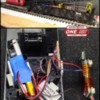I don't know about DC versions of BPRC, but if one has DCC already the following might be of some use: Last year I made a test rig with a DCC operated Overland MP15AC chassis that had sound, but there's more room in a steamer to add the smoke unit as well. 
Bob, I'm not sure it's allowed to post links and prices here of non-advertisers but here's the basic info:
The first step was to replace the Pittman motor with a Maxon RE25 coreless motor (used or surplus). That dropped the typical current draw in normal use from about 2-3A to under 0.5A with similar torque, allowing longer battery life or a smaller/cheaper battery. It also enables the use of a Stanton BPS-v4 battery manager.
The BPS-v4 is a neat device imho that steps up the Voltage to 11V which is fine for the coreless motor. It allows the loco to run on dead rail and also to re-charge on DCC or DC powered track automatically. As well it takes care of the safe management of the Li-Po batteries and lets you turn the whole shebang on and off from outside the shell with a magnet wand. The battery pack is a Stanton BPS 2P 850mAh.
The corless motor needs only a "HO-sized" decoder with a current capacity of around 1-1.2A. In my case a Loksound Select (now LS5DCC). Any brand of sound decoder of similar spec would work fine of course.
There's a Tam Valley DRS1 wireless receiver in the loco and Tam Valley transmitter at the command station. These are now DeadRail Installs products I think. That sends the same DCC signal as would normally be in the track wirelessly to the decoder in the loco.
The speaker is a Tang Band 1925s. In an O scale steamer one could add a larger speaker or two.
As well there'd be room for a Loksound dual-fan smoke unit that would allow separate synchronized chuffs from one fan, and manual or speed-related smoke emissions from the blow down valves (not sure if that's the the proper name), and when the whistle's blown etc. This would require require a higher-current capacity decoder such LS 5DCC "L" or "XL" as used in O or G scale locos which would also provide power to the smoke unit. Plus such decoders have servo-drive outpuits for couplers etc. You would need a larger battery no doubt but such is life, and at least there's more space available. 
Here's my jury-rigged first test of the MP15AC chassis. Eveything shown does fit in the shell and fuel tank without giving up the cab interior, just...
The starting off got a lot smoother once I tuned it. As well the background hiss is from my stupid phone camera not the loco.
HTH
Pete









